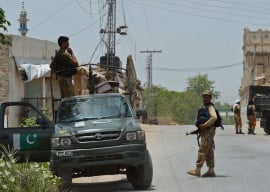
Local officials said 23 bodies have been found on the popular Annapurna circuit trekking route, while five climbers who were staying at a mountain base camp when it was hit by an avalanche could not be found and were presumed dead.
Three Nepalese yak herders were also killed when severe weather triggered by the tail end of Cyclone Hudhud hit the picturesque Annapurna region in central Nepal.
But the majority of victims were tourists -- among them Canadians, Israelis and Indians -- and their guides and porters.
"We have made a lot of progress today: we have airlifted 154 people to safety, including 76 foreigners," said Ganesh Rai, the police official in charge of the rescue effort.
As dusk fell, strong winds picked up in the affected districts of Manang and Mustang, making it too risky for pilots to continue scanning the snow-blanketed slopes for signs of victims, officials said.
Thousands of people head to the Annapurna region every October, when weather conditions are usually clear and cool, and 168 foreign tourists were registered to hike in the affected districts this week.
Israelis Yakov Megreli and Maya Ora were 10 days into their trek when the storm hit, forcing them to stop overnight at a freezing teashop.
"We tried not to sleep so that we wouldn't get hypothermia. It was very frightening, awful," Megreli, 24, told AFP.
"All the time I thought I was going to die," said Ora, 21, before Nepalese troops found the pair and brought them to a military hospital in Kathmandu to be treated for frostbite.
A US hiker told AFP he sought refuge at a Manang guesthouse, along with 21 tourists and four Nepalese guides and porters, after finding himself in the grip of the snowstorm.
"We left our hotel in Thorong Phedi at 0630 am on Tuesday, with hotel staff telling us it was totally safe to go up," said Max Weinstein, 18, by phone from the guesthouse in Thorong High Camp, at an altitude of 4800 metres (15,748 feet).
As he and a 66-year-old woman he was trekking with hiked on, visibility worsened as more and more snow began to come down.
"The snow kept getting heavier, we couldn't see anything, and soon these big rocks began falling down," he said.
Weinstein said he would never have headed out on Tuesday if he had been given prior warnings.
"Whoever is in charge of communicating weather warnings to trekkers has been totally negligent," he said.
Keshav Pandey, vice president of the Trekking Agencies' Association of Nepal (TAAN), an industry body, said the Himalayan nation has no warning systems in place to inform trekkers of severe weather conditions.
"We don't expect this kind of storm in October, but we also have no warning system to help us prepare for it," Pandey told AFP.
Rescuers were searching for two Slovakian mountaineers and three Nepalese guides who went missing after an avalanche struck teams stationed at the base camp of 8,167-metre (26,795 foot) Mount Dhaulagiri on Tuesday night.
"We are running helicopter missions to try and find them, but we can find no sign of them, we presume they are dead," said police official Rai.
Rescuers have retrieved the bodies of three Israelis, three Poles, one Vietnamese, one Slovak and seven Nepalese, while the bodies of four Canadians and three Indians remain buried in snow, Rai said, correcting an earlier statement that misidentified one of the victims as a German.
The nationality of three others found was unknown, he said.
At least seven of the hikers lost their lives in an avalanche in Manang and 16 others were buried by the snowstorm in neighbouring Mustang, according to a local official.
The region has seen unusually heavy snowfall this week sparked by Cyclone Hudhud, which slammed into India's east coast over the weekend.
The latest disaster follows the deaths of 16 people in an avalanche on Mount Everest in April that forced an unprecedented shutdown of the world's highest peak.
Scores of expeditions were cancelled after the avalanche tore through a group of sherpas who were hauling gear up the mountain for their foreign clients.
The effective closure of the 8,848-metre (29,029-foot) mountain for the season dealt a huge blow to impoverished Nepal, which relies heavily on tourism revenues from climbing and trekking.


















1713893627-4/Shredded-10,000-yen-bill-(1)1713893627-4-270x192.webp)

1713889672-1/Plastic-waste-(2)1713889672-1-270x192.webp)






















COMMENTS
Comments are moderated and generally will be posted if they are on-topic and not abusive.
For more information, please see our Comments FAQ